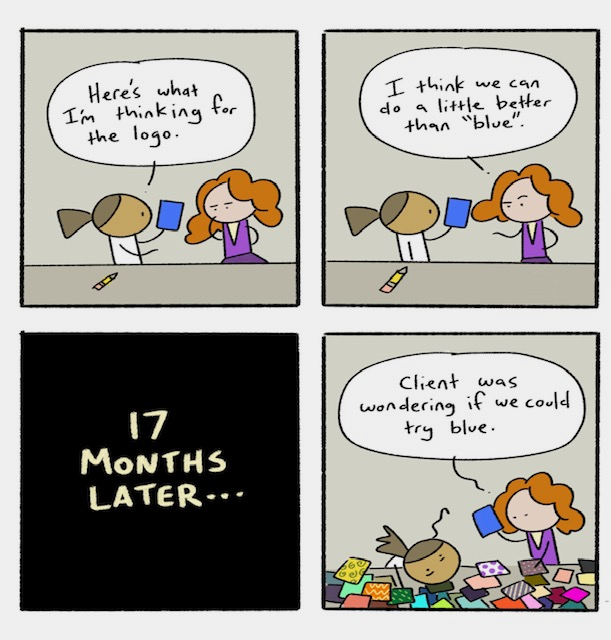Pro tip: When going to a job interview, don’t bring your mommy along with you. That advice may seem obvious, but it’s needed, apparently. According to The Wall Street Journal, “Recruiters and hiring managers say they are seeing an uptick in parents inserting themselves into their children’s professional lives, calling up hiring managers, applying for jobs on their behalf and even showing up on the job to help mediate conflicts.”
One HR coordinator shared that some parents lead the way into the interview room, causing confusion as to who is actually seeking the job. This same professional also recounted being confronted by an employee’s mom over a raise she deemed not big enough. But like most forms of helicopter parenting, it’s hard to believe these next-gen workers are being served well by their parents’ interference. After all, how can you grow and become an independent professional if mommy and daddy are holding your hand and telling you what to say?
Besides, employers who hire minors already have enough to worry about. A better scenario for all involved is an apprenticeship program through which younger workers can gain the hands-on experience and guidance they need from actual business leaders — without nosy parents getting in the way.
Start your weekend with our first-ever edition of b. Trivia: What major tech company is closely associated with back rubs? Click here for the answer!
|
Gen Z Tech Shame: It’s Real, and Here’s How to Fix It
|
2023 is only at the halfway point, and we’ve already racked up some new buzzwords: digital dust, X analytics and Gen Z tech shame, here we come. On that last one, a surprising number of reports have illuminated a major misconception: Employers wrongly assume that younger workers are innately tech-savvy because they grew up online, with smartphones in hand.
On the contrary, an HP survey of 10,000 worldwide workers reveals that 1 in 5 young office workers feel judged for having tech issues and 25 percent avoid participation in remote meetings for fear that technology might cause a disruption. LaSalle Network reports that tech skills were the No. 1 thing the Class of 2022 felt unprepared for. This group is also 10 times more likely to feel shame when they encounter these issues.
How did a generation raised on the internet get here? In a Dell Technologies survey of 15,000 workers aged 18 to 26, 37% said their school education didn’t equip them with the tech skills they need at work. Likewise, the less privileged (and still entry-level) new gen of employees often lack the funds for the swanky remote gear afforded to their peers. On top of that, this crop of workers is coming into jobs in fully or partially virtual settings, which has led to a vacuum of the face time that’s often essential for learning the ropes, tech-related or otherwise.
And still, when you have a multigenerational workforce, Gen Z workers are habitually relied upon as casual tech support for older colleagues, perpetuating the cycle. As an employer, here’s what you can do to help break it:
- Provide better technology training before your employees ask for it. Keep in mind that many of these workers started their career during the pandemic — they didn’t get the hands-on training that your other employees got in, say, 2015.
- Include the whole team in your training initiatives to avoid skill gaps, which heighten tech shame. Consider hiring a teacher capable of organizing a robust learning and development program.
- Check in, check in, and check in. Don’t just assume that your whole crew is up to speed when it comes to the software, digital tools and other tech equipment you expect them to use. When people feel ashamed, they’re less likely to speak up when they’re left behind.
- While you’re checking in, ask your remote employees about access to the gear they need, especially if you rely on a BYOD policy. If you’re able, help provide them the tools they need to even the playing field.
Daring Greatly author Brené Brown wrote, “Shame derives its power from being unspeakable.” If you’re welcoming younger folks into the workforce in 2023, you have the power to speak up, and turn the tech-shameful toward a future that’s tech-savvy.
While Gen Z may be struggling, find out the ways tech-loving millennials are changing the way we work, from texting to tweeting.
|
Larry Page and Sergey Brin initially called their search engine Backrub before changing the name to Google in the company’s second year.
Imagine how awkward it would’ve been to tell your parents to “Backrub it” every time they asked you a question!
|
Turnover: How It Impacts the Rest of Your Team, Especially Your Stars
|
Dr. Steven Rogelberg is a Chancellor’s Professor at UNC Charlotte and former president of the Society for Industrial and Organizational Psychology.
A unique study in the Academy of Management Journal examined three routes to a job exit that are most typical in organizations and how they affect the retention of others. To do so, the researchers looked at turnover in more than 1,500 large retail organizations across nearly two years’ time.
The first exit path is dismissal. In this situation, a poor-performing employee or worker who broke some key rule is let go. When this happens, research suggests that remaining employees who choose to leave after witnessing this type of turnover are those who also aren’t performing well. Your star employees will tend to stay. In fact, the authors discuss that for these star performers, they may actually feel better about staying after seeing poor performers exit.
The second exit path is layoffs. This is typically due to a financial downturn or economic vulnerability experienced by the organization. When these layoffs are made agnostic of actual performance, some unintended consequences may arise. Namely, when high-performing employees are laid off, it appears that other top workers not directly affected by the layoffs will seek to exit over time. This is because they may question the organization’s commitment to them, thinking it may be quite fragile.
|
|
|
The third exit path is volunteer resignation. Volunteer resignation can have a contagious effect where one person leaving can trigger others to evaluate their place in the organization. This becomes particularly problematic when the person leaving is a high performer. Other high performers will in turn question whether they should stay or not. Like path two, if star employees exit, it can very likely result in other top talent choosing to depart, which clearly is not a desirable outcome.
Implications
Be sure your high-performing employees are identified and nurtured. These vital employees should be made to feel safe, secure, and appreciated. They should know they have an excellent future with the organization, even during rocky times.
When conducting layoffs, make sure your star workers are either exempt from the layoff and/or offered other positions in the organization as part of a retention effort.
For those employees performing poorly, if your corrective efforts fail, a timely termination letter is appropriate and can result in two positive outcomes: other low performers leave and high performers feel more confident to stay.
|
On June 9 in Business History
|
- 1650: The Harvard Corporation was established, making it the first legal corporation in the Americas.
- 1790: The Philadelphia Spelling Book became the first copyrighted book under the U.S. Constitution.
- 1931: Robert Goddard received his patent for the first rocket-powered aircraft.
- 1934: Donald Duck made his first appearance in The Wise Little Hen. His uncle, Scrooge McDuck, is the highest-grossing Disney character of all time with a net worth of $65 billion.
- 1986: The Dow Jones Industrial Average had, at the time, its largest one-day drop of 45.71 points.
|
|
|
Written by Dan Ketchum and Aaron Goldfarb. Comic by John McNamee.
|
|
|
|





